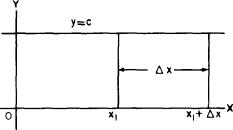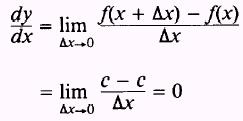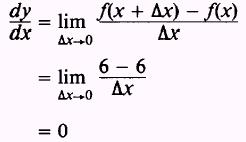|
CHAPTER 5 DERIVATIVES
LEARNING
OBJECTIVES
Upon
completion of this chapter, you should be able to do the following:
1.
Compute the derivative of a constant.
2.
Compute the derivative of a variable raised to a power.
3.
Compute the derivative of the sum and product of two or more functions and the
quotient of two functions.
4.
Compute the derivative of a function raised to a power, in radical form, and by
using the chain rule.
5.
Compute the derivative of an inverse function, an implicit function, a
trigonometric function, and a natural logarithmic function.
6.
Compute the derivative of a constant raised to a variable power.
INTRODUCTION
In
the previous chapter on limits, we used the delta process to find the limit of
a function as Ax approached zero. We called the result of this tedious and, in
some cases, lengthy process the derivative. In this chapter we will examine
some rules used to find the derivative of a function without using the delta
process. To find how y changes as x changes, we take the limit of


which is called the derivative of y with respect to x; we
use the symbol
 to indicate the derivative and
write
to indicate the derivative and
write

In this section we will learn a number of rules that will
enable us to easily obtain the derivative of many algebraic functions. In the
derivation of these rules, which will be called theorems, we will assume that

or

exists and is finite.
DERIVATIVE OF A CONSTANT
The method we will use to find the derivative of a
constant is similar to the delta process used in the previous chapter but includes
an analytical proof. A diagram is used to give a geometrical meaning of the
function.
Theorem 1. The derivative of a constant is zero. Expressed as a formula, this may be written as

where y = c.
PROOF: In figure 5-1, the graph of

Figure 5-1.-Graph of y = c, where c is a constant.
y=c
where c is a constant, the value of y is the same for all
values of x, and any change in x (that is,
 x) does not
affect y; then
x) does not
affect y; then

and

Another way of stating this is that when x is equal to x1
and when x is equal to
 has the same value. Therefore,
has the same value. Therefore,
y=c
and

so that

and

Then

The equation

represents a straight line parallel to the X axis. The
slope of this line will be zero for all values of x. Therefore, the derivative
is zero for all values of x.
EXAMPLE.
Find the derivative
 of the
function
of the
function

SOLUTION:

and

Therefore,

|

